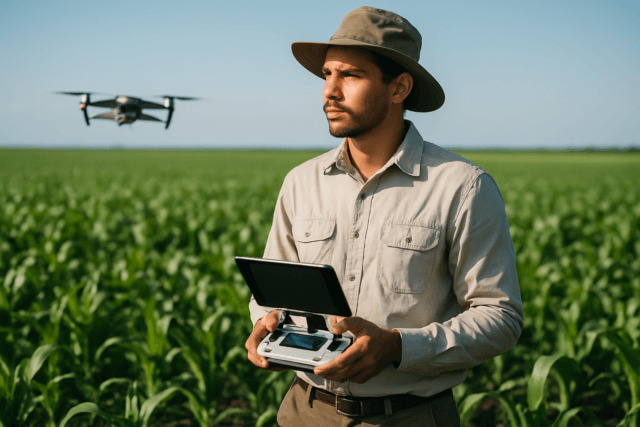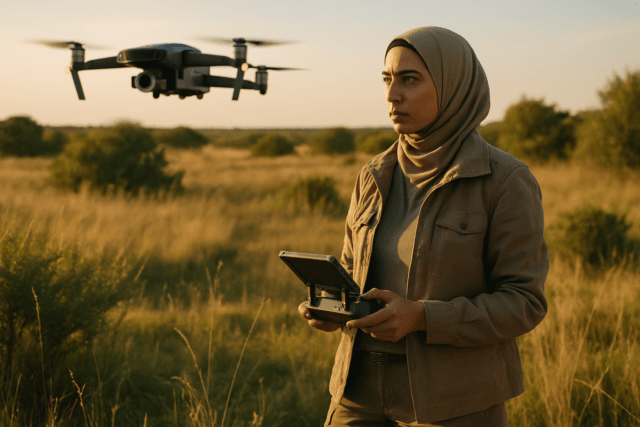The drone industry is soaring to new heights, presenting a wealth of investment opportunities across various sectors. From defense and security to commercial applications like delivery, agriculture, and infrastructure inspection, drones are transforming industries and creating lucrative prospects for investors in the UK and globally. As we navigate the evolving landscape of drone technology, understanding market trends, key players, and potential challenges is crucial for making informed investment decisions.
The Sky’s the Limit: Drone Market Growth and Projections
The global drone market is experiencing unprecedented growth, driven by technological advancements, increasing regulatory approvals, and expanding demand across commercial and military applications. Several reports highlight the impressive trajectory of the drone industry:
- Global Market Size: The global drone market is estimated at USD 73.06 billion in 2024 and is projected to reach USD 163.60 billion by 2030, growing at a CAGR of 14.3% from 2025 to 2030. This substantial growth is attributed to advancements in drone technology, improved battery efficiency, AI-powered autonomous systems, and enhanced imaging sensors.
- Commercial Drone Market: The commercial drone sector is set to expand from $11.1 billion in 2023 to an impressive $24 billion by 2029, reflecting a strong CAGR of 13.8%. This growth is powered by increasing investments in drone technology, evolving regulatory frameworks, and the expanding range of applications beyond traditional uses.
- Delivery Drones Market: The global delivery drones market is witnessing significant growth, projected to grow from $1.8 billion in 2023 to $12.3 billion by 2028, at an impressive CAGR of 46.5% during the forecast period. This exponential rise is fueled by increasing demand for faster deliveries, improved drone capabilities, and regulatory progress facilitating commercial drone operations.
- Drone-as-a-Service (DaaS): The “drones as a service” segment is expected to reach $29.4 billion by 2025. The drone hardware industry is also the fastest-growing segment.
- Global Drone Flights: The number of global drone flights jumped 25% in 2024, with takeoffs rising from an estimated 15.5 million to 19.5 million. Asia saw the most flights at 6.3 million, followed by North America (3.9 million) and Europe (3.8 million).
These figures underscore the immense potential of the drone market and the opportunities available for investors seeking exposure to this dynamic industry.
UK Drone Investment Landscape: Opportunities and Key Players
The UK is rapidly emerging as a hub for drone innovation and investment, driven by government support, a thriving tech sector, and increasing adoption of drone technology across various industries.
Government Support and Initiatives
- £4 Billion Investment: The UK government has announced a £4 billion domestic funding package to develop autonomous and uncrewed aerial systems, signaling a strong commitment to the drone industry.
- Drone Deliveries to Ukraine: The UK is significantly increasing its drone deliveries to Ukraine, with a target of 100,000 drones in 2025, backed by a record £350 million investment. This initiative supports British defense companies and creates jobs as part of the government’s Plan for Change.
- Strategic Defence Review: The UK’s Strategic Defence Review (SDR) emphasizes the importance of technology and the use of uncrewed systems across land, air, and sea domains, further driving investment and innovation in the drone sector.
- Tekever Investment: Drone manufacturer Tekever is investing £400 million to expand its operations in the UK, creating over 1,000 new jobs in engineering, advanced manufacturing, and AI development. This investment includes delivering a new RAF electronic warfare system based on its AR3 drone platform.
Key Investment Areas in the UK
- Drone Manufacturing: Companies like Tekever and Anduril Industries are establishing manufacturing facilities in the UK to produce advanced drones for defense and commercial applications.
- Drone-Based Logistics: RattanIndia Enterprises, through its subsidiary NeoSky, is investing heavily in drone-based logistics and tech development, focusing on long-range delivery drones and drone-as-a-service platforms.
- Surveillance and Security: Companies like Paras Defence and Space Technologies are developing drone and anti-drone systems for defense and surveillance applications, catering to the growing need for advanced security solutions.
- Drone Pilot Training: Drone Destination Ltd focuses on training and certification programs for drone pilots, equipping individuals and organizations with the skills required to operate drones across various industries.
- Software and AI Integration: Companies are integrating AI and machine learning into drone technology to enable autonomous navigation, real-time decision-making, and advanced object recognition, enhancing the capabilities of drones in various sectors.
- Counter-Drone Technology: Given the increasing misuse of drones, there’s a growing demand for advanced counter-drone systems in India, with companies like EndureAir working on tamper-proof systems to protect against cyberattacks and data leaks.
Notable UK Companies
- Tekever: A Portugal-founded company that builds AI-powered drones, Tekever is expanding its operations in the UK following a new contract with the Royal Air Force.
- Anduril Industries: Anduril is establishing a drone manufacturing facility in the UK, reinforcing its presence in European defense markets. Its Ghost and Altius drones are known for their versatility, agility, and AI-enhanced autonomous flight capabilities.
- RattanIndia Enterprises: Through its subsidiary NeoSky, RattanIndia is investing in drone-based logistics and tech development, aiming to make drone deliveries possible across sectors like healthcare, e-commerce, and agriculture.
Investment Strategies
- Direct Investment in Drone Companies: Investing in publicly listed or private drone companies that are developing innovative technologies and solutions.
- Venture Capital Funds: Investing in venture capital funds that focus on early-stage companies in the drone sector.
- Drone-Related ETFs: Investing in exchange-traded funds (ETFs) that have exposure to the drone sector, such as defense-focused ETFs or autonomous technology and robotics ETFs.
Global Drone Investment Opportunities: Key Companies to Watch
While the UK offers significant investment opportunities, the global drone market is also home to several key players that are worth considering:
- AeroVironment Inc. (NASDAQ: AVAV): A leading drone company with significant growth prospects, backed by reliable defense contracts and expanding commercial applications.
- EHang Holdings Ltd. (NASDAQ: EH): A world-leading urban air mobility (“UAM”) technology platform company.
- Kratos Defense & Security Solutions, Inc. (NASDAQ: KTOS): Offers investors a strong opportunity driven by sustained military demand, innovative autonomous technologies, and strategic growth into new markets.
- Amazon.com, Inc. (NASDAQ: AMZN): As Amazon expands its drone delivery operations, investors gain access to substantial growth potential, enhanced by the company’s market leadership, technological innovation, and logistical expertise.
- Parrot SA (EPA: PARRO): A European drone company that designs, develops and markets drones for professional and consumer use.
- Red Cat Holdings, Inc. (NASDAQ: RCAT): A drone company that has made breakthrough technologies and secured lucrative contracts with the U.S. military.
- Unusual Machines ($UMAC): A drone company that focuses on creating unique solutions for various industries.
Drone Technology Trends: Shaping the Future of Investment
Several key technology trends are shaping the future of the drone industry and influencing investment decisions:
- Enhanced Autonomy and AI Integration: Drones are becoming smarter than ever, thanks to advancements in artificial intelligence (AI). Autonomous navigation, real-time decision-making, and advanced object recognition are being implemented today, allowing drones to operate independently in challenging environments.
- Swarm Technology: Swarm technology enables drones to work collectively, achieving tasks faster and more efficiently than a single unit. These drone swarms can make real-time decisions without centralized control, opening new possibilities in areas such as environmental monitoring, disaster response, and large-scale construction.
- eVTOL and Urban Air Mobility Revolution: Electric Vertical Take-Off and Landing (eVTOL) aircraft are poised to redefine urban transportation. Companies are actively developing passenger drones and air taxis to reduce congestion in overcrowded cities.
- The Rise of Underwater Drones: Underwater drones are becoming essential for tasks like intelligence gathering, protecting undersea infrastructure, and environmental monitoring. These submersible drones provide cost-effective solutions compared to traditional manned submarines, opening new frontiers in exploration and surveillance.
- 5G Connectivity and IoT Integration: Integrating AI, IoT, and 5G is significantly enhancing drone capabilities, enabling more efficient operations and large-scale deployments.
Challenges and Strategic Considerations
Despite the immense potential of the drone market, investors should be aware of several challenges and strategic considerations:
- Regulatory Hurdles: Regulatory complexities, airspace constraints, and privacy concerns remain significant challenges to widespread drone adoption. Slow progress on BVLOS (Beyond Visual Line of Sight) rulemaking, excessive regulation of low-risk operations, and high compliance costs can create operational friction.
- Skilled Workforce: A shortage of skilled drone engineers, pilots, and AI experts can limit innovation and slow the growth of the drone industry. There is a need for comprehensive training programs and educational courses focused on drone technology to address this skill gap.
- Cybersecurity Vulnerabilities: Drones built with commercial off-the-shelf (COTS) components are easy targets for cyberattacks. Hacking, GPS spoofing, and data leaks are real threats, especially in defense and surveillance.
- Battery Life and Energy Efficiency: Battery life remains a significant challenge for drone operations, especially for long-duration and long-range flights.
- Public Acceptance: Public acceptance of drone operations, especially for BVLOS, is not yet fully established.
- Competition from Global Players: As the drone market grows, local companies may face increasing competition from established global players.
To navigate these challenges, companies need to focus on:
- Process Optimization: Streamlining operations and improving efficiency to reduce costs and enhance competitiveness.
- Refined Go-to-Market Approaches: Developing targeted marketing strategies to reach potential customers and increase market awareness.
- Deeper Collaboration: Fostering collaboration within the drone ecosystem to share knowledge, resources, and expertise.
- Innovation in Business Models: Offering drone-as-a-service options to make the technology more accessible and affordable.
Navigating UK Drone Regulations
Understanding and complying with UK drone regulations is crucial for both drone operators and investors. The Civil Aviation Authority (CAA) is the national aviation authority responsible for regulating drone operations in the UK.
Key Regulations
- Registration: If your drone weighs between 250g and 25kg, you need to register as an operator with the CAA. The registration fee is £11.13 and is valid for 12 months.
- Flyer ID: Anyone who wants to fly a drone must pass an online theory test to get a Flyer ID. The Flyer ID is valid for 5 years.
- Altitude Limit: Drones must be flown below the CAA’s altitude limit of 120 meters (400 feet).
- Line of Sight: Drones must always be flown within visual line of sight.
- Dangerous Areas: Drones should not be flown in dangerous areas or over crowds and urban areas.
- Airports and Airfields: Drones must stay away from aircraft, airports, and airfields.
- Commercial Operations: Commercial drone operations in the UK require permission from the CAA.
Resources for Compliance
- CAA Website: The CAA’s website provides detailed information on drone regulations, including how to apply for permissions and submit applications.
- Drone Assist App: Altitude Angel’s Drone Assist app provides an interactive map of the sky, displaying no-fly zones, ground hazards, and other important information for drone pilots.
- NATS Portal: The NATS portal allows drone operators to submit flight notifications for UAS in Flight Restriction Zones (FRZ), Restricted Areas, or CTR/CTAs/TMAs above 400ft.
By staying informed and compliant with these regulations, drone operators and investors can ensure the safe and responsible use of drone technology in the UK.
Conclusion: Investing in the Future of Flight
Drone investment opportunities are ripe with potential, offering exposure to a rapidly growing market that is transforming industries across the globe. In the UK, government support, a thriving tech sector, and increasing adoption of drone technology make it an attractive destination for drone-related investments. By understanding market trends, key players, technology advancements, and potential challenges, investors can make informed decisions and capitalize on the exciting opportunities in the drone industry. As drones continue to evolve and integrate into our daily lives, investing in this innovative sector promises significant returns and the chance to be part of the future of flight.





